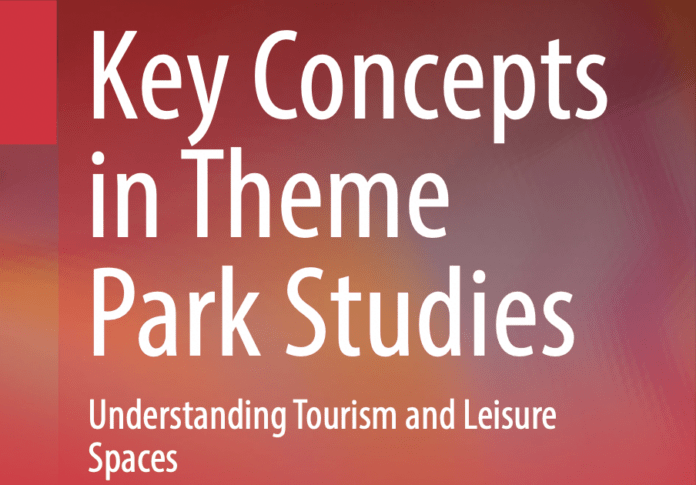by Salvador Anton Clavé, Filippo Carlà-Uhink, and Florian Freitag
The global success of theme parks and immersive environments has not gone unnoticed by academia: researchers and students from various academic disciplines have been analyzing virtually all aspects of theme parks, from their history to theming strategies, from economic aspects to visitor behavior. What has been lacking so far, however, is a reference work that disseminates the diverse and rich results of these various and interdisciplinary academic discussions to new students, professionals, and general audience. This is the goal that the authors of Key Concepts in Theme Park Studies have sought to accomplish: writing an introduction to theme park studies that covers central aspects of these spaces from multiple perspectives. Written collaboratively over a period of four years by 13 scholars from different disciplines and countries, the 17 chapters that make up this 380-page book (including numerous tables and illustrations) combine critical perspectives and analytical methods to summarize the complexity and diversity of the unique and multivalent phenomenon called “the theme park.”



The chapter on Antecedents, Origins, and Developments, for example, reconstructs the history of themed environments from Antiquity to the early 20th century and surveys the economic, aesthetic, and cultural development of theme parks since the mid-20th century. Taking their cue from the growing interest in the production of theme parks by employees and their reception by visitors and fans, the chapters on Labor and Visitors discuss labor practices in theme parks across the globe and the roles of visitors (customer, pilgrim, performer, fan, and experiencing body) in the theme park industry, respectively. The chapter on Media provides an entryway into the numerous publications on the role of theme parks in transmedial networks and the contribution of individual media to theme parks’ plurimediality; and the chapter on Paratexts and Reception offers a framework for the various studies on theme park marketing materials and theme parks’ reception in other media (think Jurassic Park or Krustyland).
Another set of “key concepts” is dedicated to terms and concepts that have been regularly used in theme park studies, yet frequently without much awareness of how complicated their use really is beyond individual academic fields. Thus, the chapter on Attractions identifies the different types of attractions in the theme park and discusses how they come together in a park-specific “attractions mix” to form one coherent narrative space. The chapter on Immersion first uses the concept of immersivity to describe theme parks’ capacity to induce an immersed state of mind in visitors. Then, the chapter focuses on the roles played by narrativity and bodily affect in the parks’ offers of immersivity. The chapter on Authenticity draws on the long debate about the term especially in tourism and museum studies and examines the sometimes parallel use of vastly different conceptualizations of authenticity in theme park marketing, design, and reception. For example, whereas theme park designers often work with a concept of perceived authenticity, according to which “authentic” is whatever corresponds to the public’s expectations, theme park marketers often rely on a more traditional idea of “museological” authenticity, stressing, for example, that a Chinese-themed area has been built with materials imported from China. The chapter on Theming, finally, defines theming, discusses general characteristics such as recognizability and exoticism, provides a history of design styles, as well as popular subcategories of themes, including self-referential and IP-based theming. However, the chapter also reflects on the limits of theming, including a section on cases of “failed theming,” and on the future of theming, specifically virtual or hybrid theming.
A third group of “key concepts” uses fundamental characteristics of theme parks and examines these through a radically transdisciplinary lens. Thus, the chapter on Space is dedicated to the spatial dimension of theme parks and investigates their being within and structuring space, including the ways in which the park’s space is materially produced by designers and performatively constructed by visitors. Likewise, the chapter on Time discusses the complex temporality of theme parks, in which several distinct temporal layers—“represented,” “experienced,” “managed,” and “external” time—continuously interact. Both the spatiality and the temporality of theme parks are implicated in their planning and design as well as in their operational strategies, which are examined as part of the chapter on Economic Strategy. Perhaps even more importantly, this chapter discusses environmental, social, and governance strategies in the theme park economy and examines how theme park operators have striven to become and to be perceived as more sustainable.
One may think of sustainability as a worldview that is sometimes even reflected in the overall message or brand of a park such as Disney’s Animal Kingdom or Xcaret. The chapter on Worldviews analyzes such worldviews (and relevant ideologies) as they are reflected in the parks’ design and marketing, from nationalism, regionalism, and capitalism to religion and environmentalism. The Industry chapter, in turn, seeks to disentangle the system of the global theme park industry by outlining the different types of theme parks, the importance of the main theme park companies and brands in the evolution of the industry, and the role of the many diverse players that participate in the delivery of the theme park experience, respectively. It also identifies theme park clusters and networks and offers comments on the impact of the COVID-19 pandemic on the industry. The chapter on Inclusion And Exclusion emphasizes how exclusions based on class, race, gender, sexuality, or able-bodiedness manifest themselves at both physical or spatial as well as symbolic levels in the theme park, and discusses how people involved in the theme park – managers, front-line employees, and visitors – have worked towards removing them. Finally, the chapter on Methods talks about scholars’ research experiences within theme parks,identifies the various challenges one may encounter when studying theme parks, and it also contains practical hints for field research in a theme park or themed environment.
The book represents, as it says in the introduction, an “invitation to undergraduate students, established scholars, newcomers to the field, experts and professionals, and everyone else interested in the topic, to join [the authors] in the transdisciplinary scholarly discussion about theme parks.” Key Concepts in Theme Park Studies is available as a hard cover, PDF, or Kindle version.






